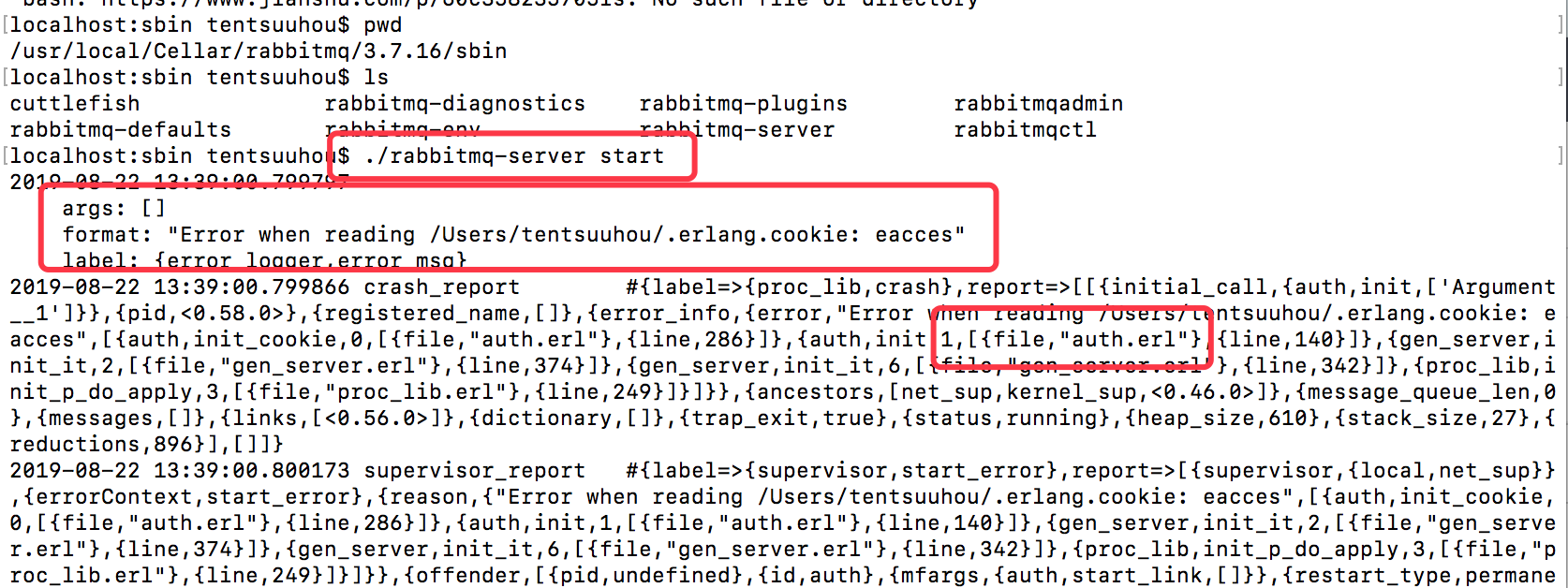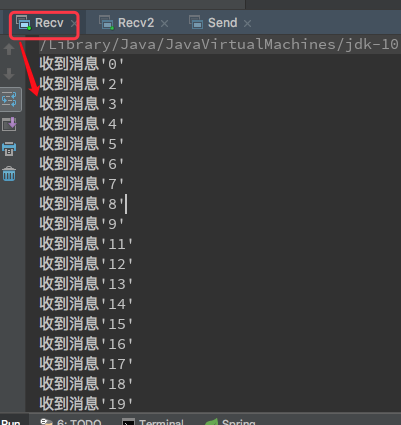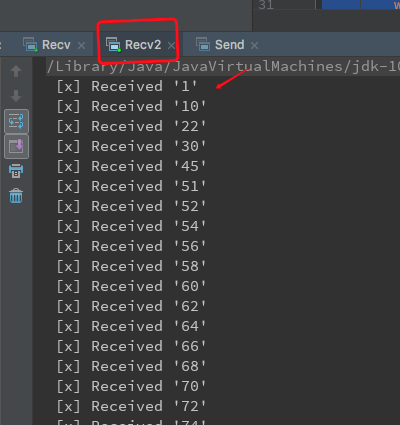1、安装
mac安装rabbitmq 需要注意的是,mac安装rabbitmq,启动的时候命令前,需要加 sudo,不然会报错误

2、rabbitmq 开发概念词

2.1 Producer(生产者)
2.2 Consumer(消费者)
2.3 Exchange(交换机)
2.4 Queue(队列)
2.5 rountingKey(交换机与队列之间的关系)
3、RabbitMQ开发方案
官网的6中模式,可以点开这个网址,显示6中模式,第6中模式RPC远程调用我们不需要用该模式,所以我们只要关注前五种就可以了。
接下来我们就直接简单教学rabbitmq的简单使用
3.0 代码讲解
/**
* 声明队列,五个参数列表,如果直接使用默认channel.queueDeclare("queue"),那么其他参数都会自动默认设置属性,所以一般我们几乎都默认它
* String queue 队列名称
* boolean durable 队列是需要持久化,意思就是rabbitmq重启的时候,如果不是持久化,那么该队列就会消失,默认true
* boolean exclusive 如果你想创建一个只有自己可见的队列,不允许其它用户访问RabbitMQ允许你将一个Queue声明成为排他性的,只对首次声明它的连接(Connection)可见,会在其连接断开的时候自动删除。所以我们开发中一般不需要此操作,默认false
* boolean autoDelete 消息是需要持久化,意思就是rabbitmq重启的时候,如果为true,那么关闭期间接受的消息就会自动消失,默认false
* Map<String, Object> arguments 这个参数我们只会在使用延迟队列中才会用到,就是延迟队列的相关配置等属性
* 方法channel.queueDelete("queue")等同于channel.queueDeclare("queue",true,false,false,null);
*/
channel.queueDeclare(QUEUE_NAME, false, false, false, null);
/** * 绑定队列到交换机 * String queue 队列名 * String exchange 交换机名 * String routingKey 绑定关系 如 大头儿子,小头爸爸 他们的rountingKey就是父子 */ channel.queueBind(QUEUE_NAME, EXCHANGE_NAME, "*.*");
3.1 pom.xml
版本随意,本博客任何版本高版本也行。
<dependency> <groupId>com.rabbitmq</groupId> <artifactId>amqp-client</artifactId> <version>3.4.1</version> </dependency> <dependency> <groupId>org.slf4j</groupId> <artifactId>slf4j-log4j12</artifactId> <version>1.7.7</version> </dependency> <dependency> <groupId>org.apache.commons</groupId> <artifactId>commons-lang3</artifactId> <version>3.3.2</version> </dependency> <dependency> <groupId>org.springframework.amqp</groupId> <artifactId>spring-rabbit</artifactId> <version>1.4.0.RELEASE</version> </dependency>
3.2 工具类准备
import com.rabbitmq.client.ConnectionFactory;
import com.rabbitmq.client.Connection;
public class ConnectionUtil {
public static Connection getConnection() throws Exception {
//定义连接工厂
ConnectionFactory factory = new ConnectionFactory();
//设置服务地址
factory.setHost("localhost");
//端口
factory.setPort(5672);
//设置账号信息,用户名、密码、vhost
factory.setVirtualHost("/");
factory.setUsername("guest");
factory.setPassword("guest");
// 通过工程获取连接
Connection connection = factory.newConnection();
return connection;
}
}
3.3 简单模式(simple)
理解:该rabbit服务器只有一个单一的队列
import com.rabbitmq.client.Channel;
import com.rabbitmq.client.Connection;
public class Send {
private final static String QUEUE_NAME = "test_queue";
public static void main(String[] argv) throws Exception {
// 获取到连接以及mq通道
Connection connection = ConnectionUtil.getConnection();
// 从连接中创建通道
Channel channel = connection.createChannel();
// 声明(创建)队列
channel.queueDeclare(QUEUE_NAME, false, false, false, null);
// 消息内容
String message = "Hello World!";
channel.basicPublish("", QUEUE_NAME, null, message.getBytes());
System.out.println(" [x] Sent '" + message + "'");
//关闭通道和连接
channel.close();
connection.close();
}
}
public class Recv {
private final static String QUEUE_NAME = "mujiutian_queue";
public static void main(String[] argv) throws Exception {
// 获取到连接以及mq通道
Connection connection = ConnectionUtil.getConnection();
//创建channel
Channel channel = connection.createChannel();
//创建队列
channel.queueDeclare(QUEUE_NAME, false, false, false, null);
// 定义队列的消费者
QueueingConsumer consumer = new QueueingConsumer(channel);
//监听队列,发送消息
channel.basicConsume(QUEUE_NAME, true, consumer);
// 获取消息,该线程一直进行
while (true) {
QueueingConsumer.Delivery delivery = consumer.nextDelivery();
String message = new String(delivery.getBody());
System.out.println("获取到消息"+message);
}
}
}
先打开rece的main函数,这样就可以执行send发送消息。
3.4 工作模式(work)
理解:rabbit服务器有一个exchange(交换机),该交换机下有两个队列,总共发送了100条消息,A队列效率高可以抢到80条消息给消费者,B队列只能抢到20条消息给发送者,他们的总和是100条,为工作模式。
先执行,先执行消费者main函数,在看结果图:
import com.rabbitmq.client.Channel;
import com.rabbitmq.client.Connection;
public class Send {
private final static String QUEUE_NAME = "test_queue_work";
public static void main(String[] argv) throws Exception {
// 获取到连接以及mq通道
Connection connection = ConnectionUtil.getConnection();
Channel channel = connection.createChannel();
// 声明队列
channel.queueDeclare(QUEUE_NAME, false, false, false, null);
for (int i = 0; i < 100; i++) {
// 消息内容
String message = "" + i;
channel.basicPublish("", QUEUE_NAME, null, message.getBytes());
System.out.println(" [x] Sent '" + message + "'");
}
channel.close();
connection.close();
}
}
import com.rabbitmq.client.Channel;
import com.rabbitmq.client.Connection;
import com.rabbitmq.client.QueueingConsumer;
public class Recv {
private final static String QUEUE_NAME = "test_queue_work";
public static void main(String[] argv) throws Exception {
// 获取到连接以及mq通道
Connection connection = ConnectionUtil.getConnection();
Channel channel = connection.createChannel();
// 声明队列
channel.queueDeclare(QUEUE_NAME, false, false, false, null);
// 同一时刻服务器只会发一条消息给消费者
channel.basicQos(10);
// 定义队列的消费者
QueueingConsumer consumer = new QueueingConsumer(channel);
// 监听队列,手动返回完成
channel.basicConsume(QUEUE_NAME, false, consumer);
// 获取消息
while (true) {
QueueingConsumer.Delivery delivery = consumer.nextDelivery();
String message = new String(delivery.getBody());
System.out.println("收到消息'" + message + "'");
// 返回确认状态
channel.basicAck(delivery.getEnvelope().getDeliveryTag(), false);
}
}
}
import com.rabbitmq.client.Channel;
import com.rabbitmq.client.Connection;
import com.rabbitmq.client.QueueingConsumer;
public class Recv2 {
private final static String QUEUE_NAME = "test_queue_work";
public static void main(String[] argv) throws Exception {
// 获取到连接以及mq通道
Connection connection = ConnectionUtil.getConnection();
Channel channel = connection.createChannel();
// 声明队列
channel.queueDeclare(QUEUE_NAME, false, false, false, null);
// 同一时刻服务器只会发一条消息给消费者
channel.basicQos(1);
// 定义队列的消费者
QueueingConsumer consumer = new QueueingConsumer(channel);
// 监听队列,手动返回完成状态
channel.basicConsume(QUEUE_NAME, false, consumer);
// 获取消息
while (true) {
QueueingConsumer.Delivery delivery = consumer.nextDelivery();
String message = new String(delivery.getBody());
System.out.println(" [x] Received '" + message + "'");
channel.basicAck(delivery.getEnvelope().getDeliveryTag(), false);
}
}
}
如图:


// 同一时刻服务器只会发一条消息给消费者 channel.basicQos(1);
跟这个有关系,这也就是我们所说的工作模式
3.5 订阅模式(Publish/Subribe)
理解:就是群发,该交换机下的所有队列,都会接受相同的所有交换机发来的消息,类似于qq群一样
import com.rabbitmq.client.Channel;
import com.rabbitmq.client.Connection;
public class Send {
private final static String EXCHANGE_NAME = "test_exchange_fanout";
public static void main(String[] argv) throws Exception {
// 获取到连接以及mq通道
Connection connection = ConnectionUtil.getConnection();
Channel channel = connection.createChannel();
// 声明exchange
channel.exchangeDeclare(EXCHANGE_NAME, "fanout");
// 消息内容
String message = "Hello World!";
channel.basicPublish(EXCHANGE_NAME, "", null, message.getBytes());
System.out.println(" [x] Sent '" + message + "'");
channel.close();
connection.close();
}
}
import com.rabbitmq.client.Channel;
import com.rabbitmq.client.Connection;
import com.rabbitmq.client.QueueingConsumer;
public class Recv {
private final static String QUEUE_NAME = "test_queue_work";
private final static String EXCHANGE_NAME = "test_exchange_fanout";
public static void main(String[] argv) throws Exception {
// 获取到连接以及mq通道
Connection connection = ConnectionUtil.getConnection();
Channel channel = connection.createChannel();
// 声明队列
channel.queueDeclare(QUEUE_NAME, false, false, false, null);
// 绑定队列到交换机
channel.queueBind(QUEUE_NAME, EXCHANGE_NAME, "");
// 同一时刻服务器只会发一条消息给消费者
channel.basicQos(1);
// 定义队列的消费者
QueueingConsumer consumer = new QueueingConsumer(channel);
// 监听队列,手动返回完成
channel.basicConsume(QUEUE_NAME, false, consumer);
// 获取消息
while (true) {
QueueingConsumer.Delivery delivery = consumer.nextDelivery();
String message = new String(delivery.getBody());
System.out.println(" [x] Received '" + message + "'");
Thread.sleep(10);
channel.basicAck(delivery.getEnvelope().getDeliveryTag(), false);
}
}
}
import com.rabbitmq.client.Channel;
import com.rabbitmq.client.Connection;
import com.rabbitmq.client.QueueingConsumer;
public class Recv2 {
private final static String QUEUE_NAME = "test_queue_work2";
private final static String EXCHANGE_NAME = "test_exchange_fanout";
public static void main(String[] argv) throws Exception {
// 获取到连接以及mq通道
Connection connection = ConnectionUtil.getConnection();
Channel channel = connection.createChannel();
// 声明队列
channel.queueDeclare(QUEUE_NAME, false, false, false, null);
// 绑定队列到交换机
channel.queueBind(QUEUE_NAME, EXCHANGE_NAME, "");
// 同一时刻服务器只会发一条消息给消费者
channel.basicQos(1);
// 定义队列的消费者
QueueingConsumer consumer = new QueueingConsumer(channel);
// 监听队列,手动返回完成
channel.basicConsume(QUEUE_NAME, false, consumer);
// 获取消息
while (true) {
QueueingConsumer.Delivery delivery = consumer.nextDelivery();
String message = new String(delivery.getBody());
System.out.println(" [x] Received '" + message + "'");
Thread.sleep(10);
channel.basicAck(delivery.getEnvelope().getDeliveryTag(), false);
}
}
}
3.6 路由模式(Routing)
理解就是:你是人,如果性别是女,请进女厕,是男性,请进男厕,如同,一个交换机下面的多个队列,根据rountingKey判断该接受的消息
import com.rabbitmq.client.Channel;
import com.rabbitmq.client.Connection;
public class Send {
private final static String EXCHANGE_NAME = "test_exchange_direct";
public static void main(String[] argv) throws Exception {
// 获取到连接以及mq通道
Connection connection = ConnectionUtil.getConnection();
Channel channel = connection.createChannel();
// 声明exchange
channel.exchangeDeclare(EXCHANGE_NAME, "direct");
// 消息内容
String message = "Hello World!";
channel.basicPublish(EXCHANGE_NAME, "key2", null, message.getBytes());
System.out.println(" [x] Sent '" + message + "'");
channel.close();
connection.close();
}
}
import com.rabbitmq.client.Channel;
import com.rabbitmq.client.Connection;
import com.rabbitmq.client.QueueingConsumer;
public class Recv {
private final static String QUEUE_NAME = "test_queue_work";
private final static String EXCHANGE_NAME = "test_exchange_direct";
public static void main(String[] argv) throws Exception {
// 获取到连接以及mq通道
Connection connection = ConnectionUtil.getConnection();
Channel channel = connection.createChannel();
// 声明队列
channel.queueDeclare(QUEUE_NAME, false, false, false, null);
// 绑定队列到交换机
channel.queueBind(QUEUE_NAME, EXCHANGE_NAME, "key");
// 同一时刻服务器只会发一条消息给消费者
channel.basicQos(1);
// 定义队列的消费者
QueueingConsumer consumer = new QueueingConsumer(channel);
// 监听队列,手动返回完成
channel.basicConsume(QUEUE_NAME, false, consumer);
// 获取消息
while (true) {
QueueingConsumer.Delivery delivery = consumer.nextDelivery();
String message = new String(delivery.getBody());
System.out.println(" [x] Received '" + message + "'");
Thread.sleep(10);
channel.basicAck(delivery.getEnvelope().getDeliveryTag(), false);
}
}
}
import com.rabbitmq.client.Channel;
import com.rabbitmq.client.Connection;
import com.rabbitmq.client.QueueingConsumer;
public class Recv2 {
private final static String QUEUE_NAME = "test_queue_work2";
private final static String EXCHANGE_NAME = "test_exchange_direct";
public static void main(String[] argv) throws Exception {
// 获取到连接以及mq通道
Connection connection = ConnectionUtil.getConnection();
Channel channel = connection.createChannel();
// 声明队列
channel.queueDeclare(QUEUE_NAME, false, false, false, null);
// 绑定队列到交换机
channel.queueBind(QUEUE_NAME, EXCHANGE_NAME, "key2");
// 同一时刻服务器只会发一条消息给消费者
channel.basicQos(1);
// 定义队列的消费者
QueueingConsumer consumer = new QueueingConsumer(channel);
// 监听队列,手动返回完成
channel.basicConsume(QUEUE_NAME, false, consumer);
// 获取消息
while (true) {
QueueingConsumer.Delivery delivery = consumer.nextDelivery();
String message = new String(delivery.getBody());
System.out.println(" [x] Received '" + message + "'");
Thread.sleep(10);
channel.basicAck(delivery.getEnvelope().getDeliveryTag(), false);
}
}
}
3.7 通配符模式(Topics)
理解就是:路径aas.# A队列接受这种所有路径,B队列接受路径下的所有队列aab.#
import com.rabbitmq.client.Channel;
import com.rabbitmq.client.Connection;
public class Send {
private final static String EXCHANGE_NAME = "test_exchange_topic";
public static void main(String[] argv) throws Exception {
// 获取到连接以及mq通道
Connection connection = ConnectionUtil.getConnection();
Channel channel = connection.createChannel();
// 声明exchange
channel.exchangeDeclare(EXCHANGE_NAME, "topic");
// 消息内容
String message = "Hello World!";
channel.basicPublish(EXCHANGE_NAME, "key.1", null, message.getBytes());
System.out.println(" [x] Sent '" + message + "'");
channel.close();
connection.close();
}
}
import com.rabbitmq.client.Channel;
import com.rabbitmq.client.Connection;
import com.rabbitmq.client.QueueingConsumer;
public class Recv {
private final static String QUEUE_NAME = "test_queue_topic_work";
private final static String EXCHANGE_NAME = "test_exchange_topic";
public static void main(String[] argv) throws Exception {
// 获取到连接以及mq通道
Connection connection = ConnectionUtil.getConnection();
Channel channel = connection.createChannel();
// 声明队列
channel.queueDeclare(QUEUE_NAME, false, false, false, null);
// 绑定队列到交换机
channel.queueBind(QUEUE_NAME, EXCHANGE_NAME, "key.*");
// 同一时刻服务器只会发一条消息给消费者
channel.basicQos(1);
// 定义队列的消费者
QueueingConsumer consumer = new QueueingConsumer(channel);
// 监听队列,手动返回完成
channel.basicConsume(QUEUE_NAME, false, consumer);
// 获取消息
while (true) {
QueueingConsumer.Delivery delivery = consumer.nextDelivery();
String message = new String(delivery.getBody());
System.out.println(" [x] Received '" + message + "'");
Thread.sleep(10);
channel.basicAck(delivery.getEnvelope().getDeliveryTag(), false);
}
}
}
import com.rabbitmq.client.Channel;
import com.rabbitmq.client.Connection;
import com.rabbitmq.client.QueueingConsumer;
public class Recv2 {
private final static String QUEUE_NAME = "test_queue_topic_work2";
private final static String EXCHANGE_NAME = "test_exchange_topic";
public static void main(String[] argv) throws Exception {
// 获取到连接以及mq通道
Connection connection = ConnectionUtil.getConnection();
Channel channel = connection.createChannel();
// 声明队列
channel.queueDeclare(QUEUE_NAME, false, false, false, null);
// 绑定队列到交换机
channel.queueBind(QUEUE_NAME, EXCHANGE_NAME, "*.*");
// 同一时刻服务器只会发一条消息给消费者
channel.basicQos(1);
// 定义队列的消费者
QueueingConsumer consumer = new QueueingConsumer(channel);
// 监听队列,手动返回完成
channel.basicConsume(QUEUE_NAME, false, consumer);
// 获取消息
while (true) {
QueueingConsumer.Delivery delivery = consumer.nextDelivery();
String message = new String(delivery.getBody());
System.out.println(" [x] Received '" + message + "'");
Thread.sleep(10);
channel.basicAck(delivery.getEnvelope().getDeliveryTag(), false);
}
}
}





















 138
138

 被折叠的 条评论
为什么被折叠?
被折叠的 条评论
为什么被折叠?








